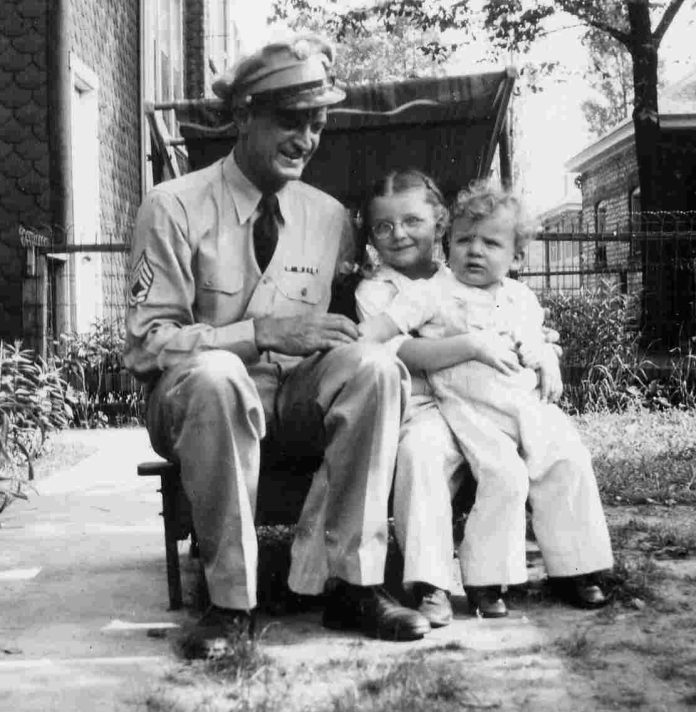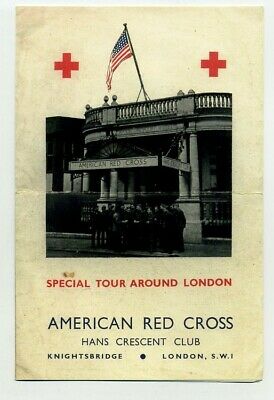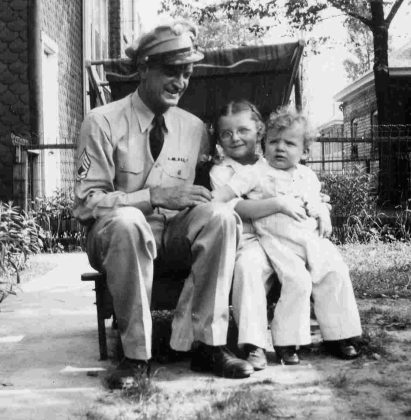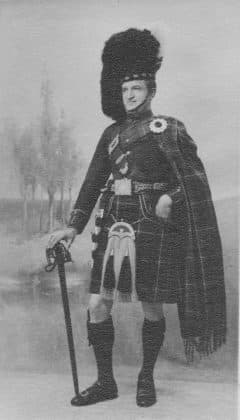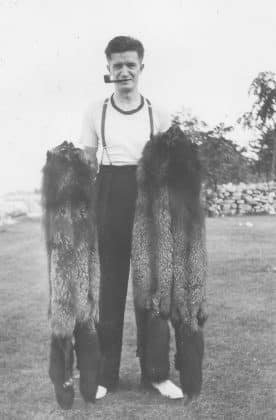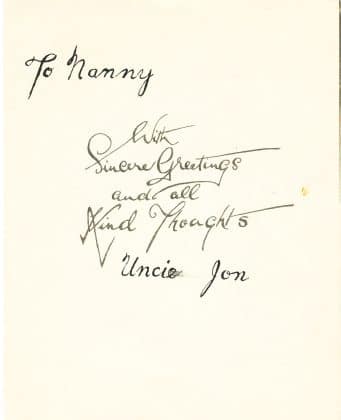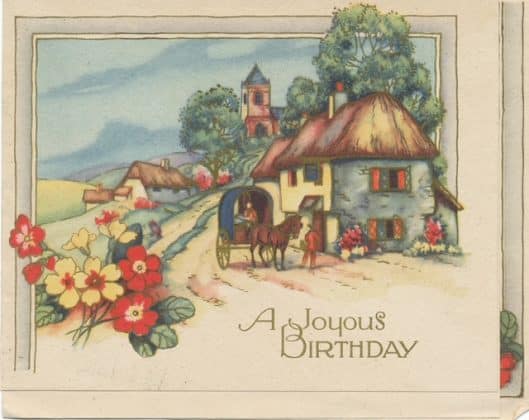My Uncle John spent 30 months in Europe during WWII while with the 8th Air Force Headquarters. He was based near London in the United Kingdom. His war letters show me that he was allowed time off to relax and recharge. He took various trips and furloughs. He had time to see some beautiful countryside and go to places he’d only ever dreamed of.
Uncle John frequently went to London, which was only about 30 miles from base. He’d often use public transportation just like a local. He took the London Underground, called the “tube.” Also, the Red Cross provided a lifeline and social network for the military during WWII. Men on leave would look up their clubs for lodging and entertainment.
On October 5, 1942 my Uncle John wrote:
“London trip was very good. I got a haircut first thing and then stayed at the Hans Crescent Club. I applied in the Washington Club for a room but they were all filled up. I walked around a bit and ate in an American-patronized restaurant. Had a hamburger steak with corn on the cob. The one ear of corn on the cob cost me 40 cents. 3 peaches are worth 50 cents each. At night I went to a dance hall–a different one from my last time here. I took the tube back to my lodging–that is after I groped around in the dark for four or five blocks.
Groping in the dark? That refers to the nightly blackouts. They were common practice during WWII, particularly around London. Their goal was to minimize outdoor light and make it harder for the enemy to see the city. Streetlights were switched off or dimmed. Traffic lights were specially fitted to shine downward. Windows and doors were covered over with heavy cardboard or thick curtains to keep light from shining out. Just think of it! If we couldn’t see to get around then maybe an enemy couldn’t see us either!
August 31, 1944 he wrote about the blackouts:
“Well, our blackouts are every night and all we do is make our way in the dark. I used your flashlight out already and could not replace the battery–too small–so I bought another one (in) which batteries can be replaced.”
Can you imagine being 4,000 miles from home during the holidays?
On December 18, 1942 he wrote:
“Well, I had a two day leave and went to London. For one, I wanted to see how London was during the Christmas days. It was rather a disappointment–for you couldn’t even tell it was Christmas time. No extra decorations, no window exhibits for the kiddies and Santa Clauses all missing from the streets. In fact, Santa Clauses are scarce even in the big stores. Toys, too, are scarce and those found are priced so high it seems absurd to pay for them.”
Uncle John never forgot about his family, especially his darling wife Mil. He remembered birthdays and anniversaries. He was always searching for the perfect greeting cards to send back home.
On January 31, 1944 he wrote:
“Went on my 36 hour pass Wednesday noon to London. Covered a lot of ground in that short period—saw four good movies, took in a dance and even managed to get a haircut. Found some birthday cards for the sis’ (his 3 sisters) which are on their way already. It’s the first time I managed to see Valentines, so I got a few for my dearest.”
In the spring of 1943 Uncle John took a trip to Windsor, just a short ride from London. He visited Windsor Castle. The castle is a working palace and official residence of today’s Queen Elizabeth II.
On April 4, 1943 he wrote:
“Saturday….my day off…I went to Windsor Castle–where the Duke of Windsor resides—and the King and Queen and princess reside. I came there a bit early so I walked around town looking for a place to eat. I was to meet a group of our boys coming from London who had special permission to visit. Civilians aren’t allowed to visit unless in a special group….
I couldn’t have picked a better day–it was ideal. The first place we entered was St. George’s Chapel–the chapel has many of the kings, queens, and lordships buried there. We were given a wonderful historical lecture for one hour….It was a wonderful tour–not one of these rushy affairs. …Afterwards….we were fortunate in seeing the princesses in the garden with their governess. They were laying down reading—garden furniture of elaborate color was all around. I did manage to get a fair look at them and they appear to be very good looking. The garden is now called a victory garden…they raise carrots and beets instead of planting flowers by the king’s wish.”
I wonder……Just who was in the garden that day? Did he see Princess Elizabeth (the future queen) or maybe a young Princess Margaret?
Some of my favorite war letters are those mentioning bits of Uncle John’s trips to Scotland. I’m missing many pages with the best of it. I can only imagine. His journeys to Scotland in late May of 1943 and mid-September of 1944 must have really been something!
I was not surprised that fishing was the first thing mentioned! Uncle John loved the outdoors! He was happiest spending summers in Wisconsin from May to September. He would stay out fishing from sunup to sundown.
But wow! He got to fish along the River Tweed! This beautiful 97 mile river flows eastward along the border with Scotland and northern England. It is famous for salmon runs! Anglers could also catch trout and grayling. It was nice that the Red Cross workers bought fishing equipment to keep aside for the soldiers.
On June 11, 1943 he wrote:
“Now that I’ve come back from my marvelous trip…..I do have tentative plans to go out there again—which I hope is before September 15—before the trout season closes. I had quite a chat with …the Red Cross Directress there and she said that they just bought a complete fishing outfit for the boys to borrow. Fishing would be done in the River Tweed, about 30 miles away–salmon and trout fishing. However, this is only a tentative set-up until my time comes to get another furlough. All I have to do is drop her a line a few weeks before and she will save the tackle for my use.”
Aunt Sue saved that postcard from the 1944 Scotland trip. It’s addressed to Janice (4) and Fred (1). They’re his little niece and nephew, the first in the family, and he adored them. He had a pet nickname for Janice, Nanny, and used it many times in the letters home.
This colorful postcard has a Highland plaid border. It frames a view of the capital city, Edinburgh, as seen from the castle. Edinburgh Castle is one of the oldest fortified places in all of Europe. What history! Can you imagine walking Castlehill and following in the footsteps of soldiers, kings, and queens?
On August 29, 1944 he wrote:
” My furlough again is going to be spent in Scotland—going with one of the fellows in the hut……Then I may go another month in Scotland. I didn’t have a chance to go on a steamer ride on the Loch Lomond, so that’s on my list….”
I wonder if he did get to finish his bucket list. Loch Lomond is the largest of the Scottish freshwater lakes, It’s over 22 miles long and nearly 5 miles wide; mountain waterfalls empty into it. The wooded forests are full of red deer, one of the largest of their species. Stone cottages and historic churches also hug its shoreline.
Uncle John liked long walks. I can picture him on a hike along the footpaths of Loch Lomond in awe of the beautiful countryside. He also loved photos! He even had one taken of himself all dressed up in full Scottish regalia, only thing missing were the bagpipes!
For a few moments WWII seemed far away. In those 30 months in Europe Uncle John got to see some wonderful places. He got his time to relax and recharge, and through his letters he was able to share it all with us back home.

